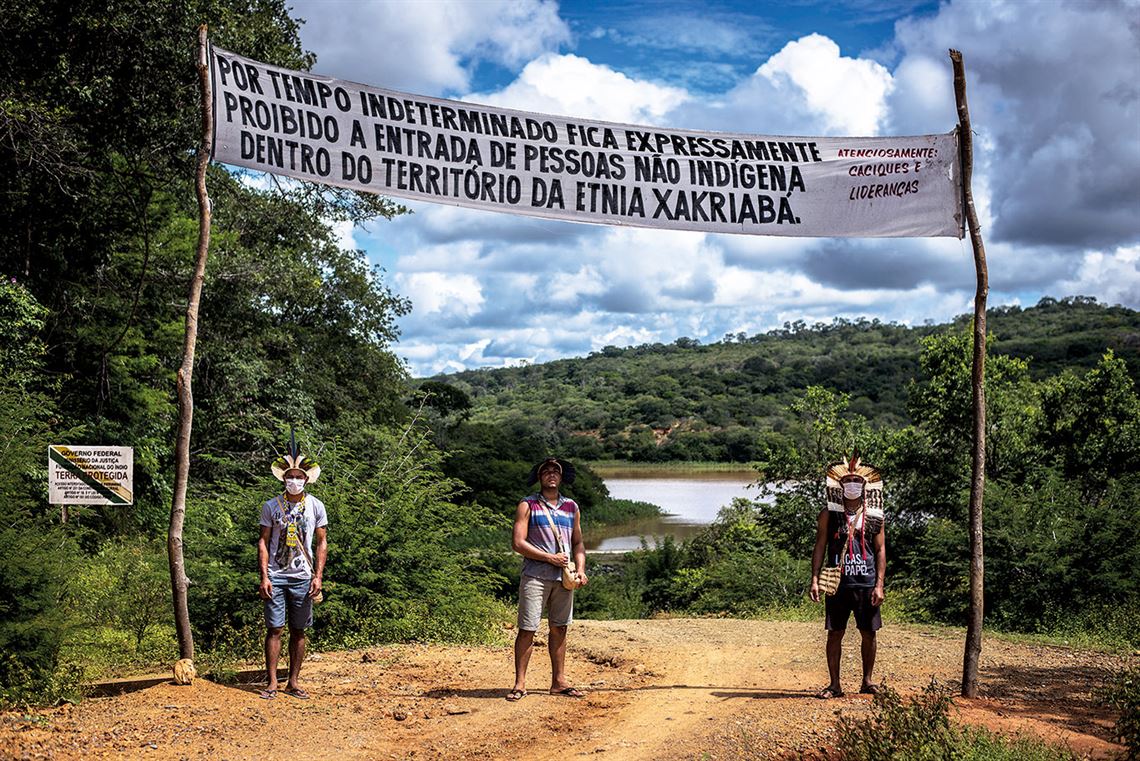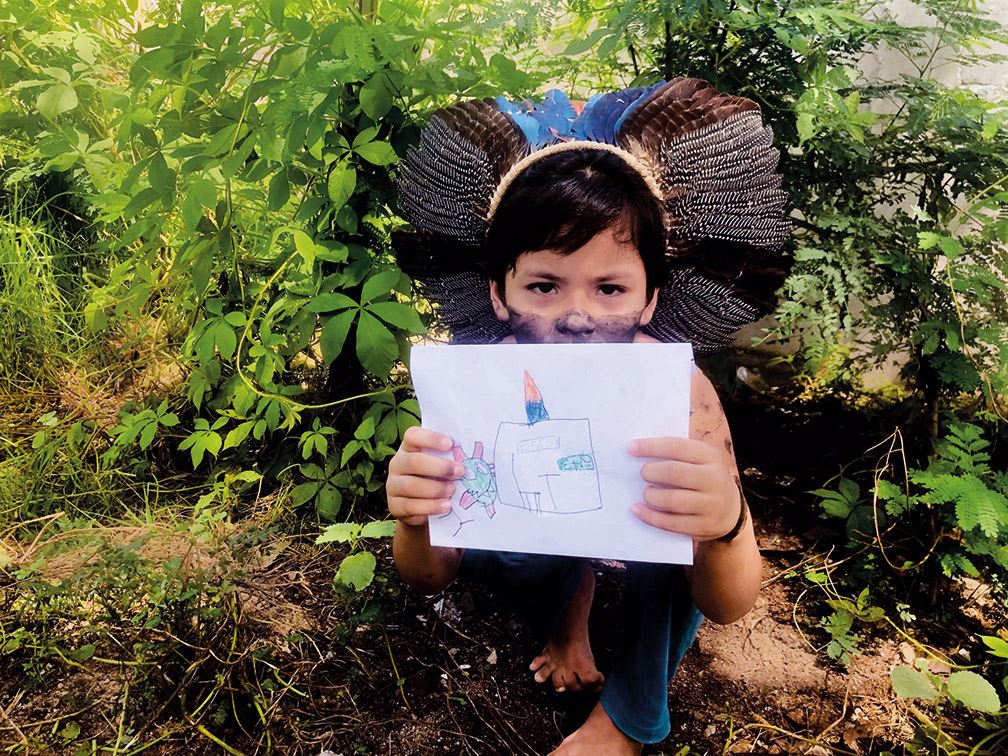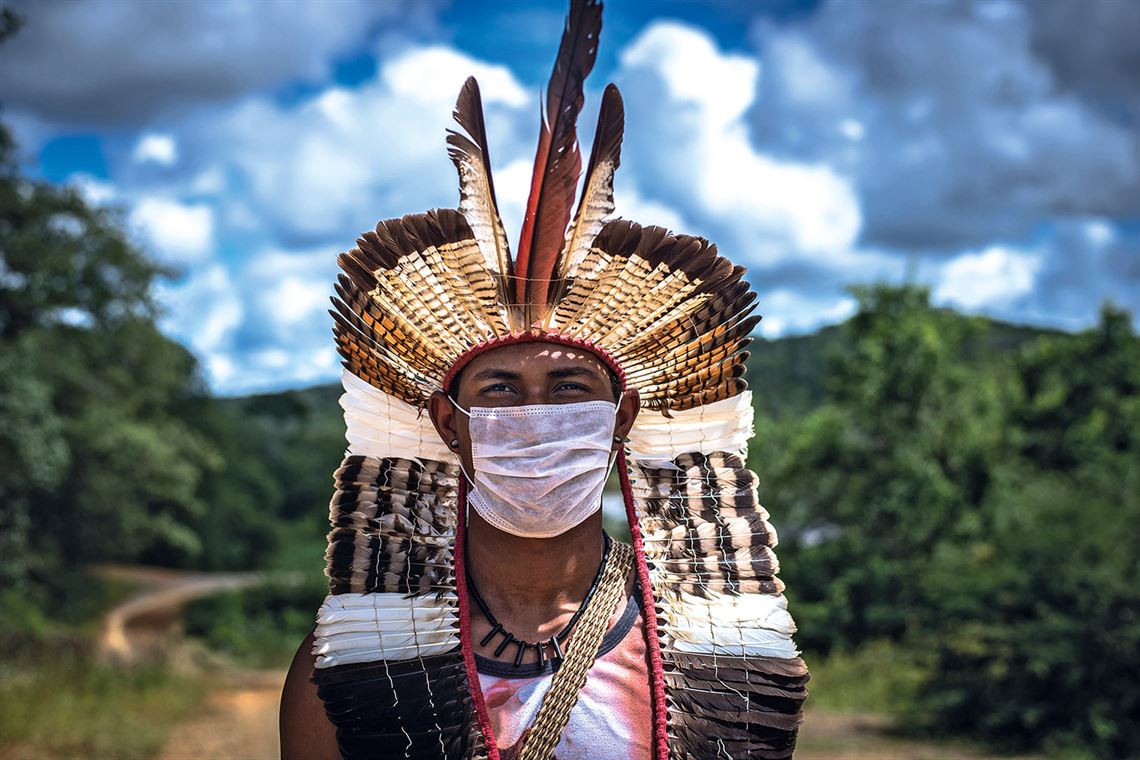The indigenous population of Brazil is a diverse community of 305 different peoples and 274 languages, from isolated, uncontacted tribes to large groups living in urban areas. The memory of foreign diseases wiping out entire villages, however, remains for all, and has been brought to the foreground by the COVID-19 pandemic in recent months. Being more vulnerable to infectious diseases and dependent on a medical subsystem with weak links to state and municipal health departments, residents of indigenous reserves are living in fear of a new genocide.
The first indigenous person to die of COVID-19 was from the Yanomami reserve—a 15-year-old boy who was already being treated for malaria—in a region dominated by mining. The death was recorded by the Special Department for Indigenous Health (SESAI) on April 10. “More than 20,000 informal miners operate illegally in Yanomami territory. In the recent past, invasions like this have led to major disease outbreaks,” says Tiago Moreira, an anthropologist and researcher on the Protected Areas Monitoring Program at the Brazilian Environmental Institute (ISA) and coordinator of the COVID-19 and Indigenous Peoples platform, which monitors daily cases in rural areas based on bulletins from state and municipal health departments. As of April 22, 42 cases of COVID-19 have been confirmed among indigenous people living in territories monitored by SESAI.
“Limitations on the availability of traditional land for maintaining indigenous ways of life and access to basic sanitation, as well as recurrent infections, malnutrition, anemia, and the emergence of chronic diseases, make indigenous populations even more vulnerable to the current epidemic,” explains Andrey Moreira Cardoso, a specialist in the epidemiology and health of indigenous populations from the Department of Endemics at the National School of Public Health of the Oswaldo Cruz Foundation (FIOCRUZ). Cardoso has studied respiratory diseases in indigenous populations, including an outbreak of influenza A (H1N1) that lasted 16 days across March and April 2016, in a Guarani village in Paraty Mirim, Rio de Janeiro State. The results were published in the journal PLOS ONE in 2019. In the article, published together with researchers from Rio de Janeiro and the UK, he analyzed how the disease progressed in 73 of the 170 indigenous people in the village who were affected. “More than 30 people were infected in just one day, leading to a sudden increase in the case curve. The outbreak mainly affected children under 5 years old, who accounted for 32.9% of the cases, despite only representing 17.6% of the population,” he notes. As well as being the majority, they were also the most seriously affected. According to Cardoso, only two of the 15 serious cases occurred in individuals over 5 years of age. The paper also states that the incidence of Severe Acute Respiratory Syndrome (SARS) in the village was 4.5 times higher than observed among the Brazilian population during the influenza outbreak in 2009. “The virus that circulated in 2016 arrived in the village earlier than expected and had mutated from the flu vaccine given the previous year, which aggravated the situation among the Guarani,” he explains.
Drawing a parallel with the current situation, Cardoso warns that the health conditions of indigenous populations in rural areas across the country have not changed, and that they are highly susceptible to SARS-CoV-2. As a result, the researcher says, the new virus could cause similar or worse damage. “We still don’t know if the pandemic will behave like influenza, affecting mainly children, who have risk factors related to malnutrition and exposure to pollution, or if it will follow the pattern seen in European countries, more severely affecting the elderly, or if both groups will be fatally affected,” says the epidemiologist.
– Science fights back
– A frightening disease
– The antivirus arsenal
– Progress toward dengue vaccine
– Vital ventilators
– In the palm of the hand
– Michel Nussenzweig: Antibody hunter
Sanitation expert Douglas Rodrigues, head of the Health and Environment Unit of the Department of Preventive Medicine at the Federal University of São Paulo’s School of Medicine (EPM-UNIFESP), says that due to the epidemiological profile of the native populations, they are one of the at-risk groups in the current pandemic, alongside the immunocompromised, the elderly, and people with chronic diseases. “Indigenous peoples are vulnerable due to multiple factors, with a high prevalence of infectious diseases and chronic illnesses, such as diabetes and hypertension, as well as high rates of obesity and malnutrition,” warns Rodrigues.
Evidence of these vulnerabilities was identified at least a decade ago by the first National Survey on Health and Nutrition of Indigenous Peoples, carried out between 2008 and 2009 by FIOCRUZ. Published in the journal Cadernos de Saúde Pública in 2019, the article “Iniquidades étnico-raciais nas hospitalizações por causas evitáveis em menores de cinco anos no Brasil (2009–2014)” (“Ethnic and racial inequalities in hospital admissions due to avoidable causes in Brazilian children aged under five”) showed that the hospitalization rate for primary care–sensitive conditions in indigenous children was five times greater than observed among white children. Compared to other races and ethnicities, indigenous people face more unfavorable conditions, with higher hospitalization rates for pneumonia and diarrhea, in addition to other infectious and parasitic diseases, in all regions of the country. In the North and Midwest, the adjusted hospitalization rates for primary care–sensitive conditions in indigenous children were 5 and 18 times the corresponding rates in white children, respectively.
Another contributing factor is the environmental problems in many territories, which make it impossible for some communities to remain isolated from cities with confirmed cases of the disease. “Forty percent of the country’s indigenous population lives in regions where nature has been devastated. As a result, hunting, fishing, and food gathering have become impractical. The indigenous people are now dependent on cities,” says Rodrigues, from UNIFESP. According to him, although villages like Parque do Xingu in the Brazilian Midwest also consume industrialized goods, the indigenous peoples there are better able to isolate themselves because of the preserved environment. “Different health policies are needed to combat coronavirus among these peoples. Communities that subsist on hunting, fishing, and gathering must remain isolated. Others that depend on nearby cities for their food need to receive supplies, so that they don’t need to travel in and out of their territories,” he proposes.
Anthropologist Gersem dos Santos Luciano, from the Department of Indigenous Education at the Federal University of Amazonas (UFAM), recalls that historically, epidemics have been responsible for severely reducing indigenous populations in Brazil. “The flu alone decimated entire villages,” he says. One flu outbreak, for example, left the Kaingang people, who lived in the state of São Paulo, on the verge of extinction after they first made contact with outsiders between 1912 and 1913, according to ISA data. Luciano, who is of Baniwa heritage and was born in the village of Yaquirana, in the Upper Negro River region of the Amazon, explains that one of the contributing factors is that indigenous people often live in community houses. “In the case of the Xapono or the Yanomami, for example, just one dwelling, called a maloca toototobi, is home to as many as 300 people. Since the SARS-CoV-2 virus has a higher transmission rate than the common flu, it can potentially be more dangerous in these environments,” he notes.

Edgar Kanaykõ Xakriabá – Ethnophotography | Anthropology
In April, leaders of the Xakriabá banned nonindigenous people from entering the reserveEdgar Kanaykõ Xakriabá – Ethnophotography | AnthropologyThe National Healthcare Policy for Indigenous Peoples celebrated its 20th year in 2019. It is implemented by the Ministry of Health’s Special Department for Indigenous Health, attending 800,000 individuals from over 34 special indigenous health districts. In 2018, Ana Lucia Pontes, a researcher from the Department of Endemics at the FIOCRUZ National School of Public Health, began studying the trajectory of indigenous participation in the formulation of the current indigenous health policy. According to her, the process began with the first National Conference on Indigenous Health Protection in 1986, where discussions focused on how national policies could respond to the health needs of indigenous peoples within the scope of Brazilian health reform, while contemplating their ways of life and perspectives. The talks took an opposing position to the approach of the military dictatorship (1964–1985), which promoted the construction of hydroelectric dams and roads in indigenous reserves, and led to numerous fatal epidemics. The Perimetral Norte highway, for example, was built in 1974 and 1975 and crosses the states of Amazonas, Pará, Amapá, and Roraima—during construction, infectious diseases killed 22% of the population in four villages, according to the ISA. Two years later, a measles epidemic killed half the population in four other indigenous communities.
“The 1988 Federal Constitution recognizes the rights of indigenous peoples, and this understanding paved the way for a specific health policy to be created based on the particular elements of their territories, social systems, ways of life, and traditional knowledge,” she says. According to Pontes, before the 1990s, national health policies for the indigenous population were implemented without considering the way they live, instead arguing that they should be assimilated and integrated into national healthcare standards.
Dialogue on traditional knowledge is one of the central axes of the Xingu Project, an EPM-UNIFESP program that has been operating in the health district of Parque Indígena do Xingu since 1965. Sanitation expert Sofia Mendonça, head of the program, explains that since the 1980s, indigenous leaders have been involved in designing the local health system. An article published in the journal Cadernos de Saúde Pública in 2019 shows that training indigenous health agents and indigenous nursing assistants was crucial to the development of preventive campaigns and early diagnoses, resulting in better strategies to combat respiratory diseases and diarrhea, for example.
Despite the improvements, Mendonça notes that one of the obstacles in the fight against COVID-19 is the primary care offered in villages and its connections with state and municipal health departments. “Indigenous health districts are not always included in state and municipal contingency plans,” highlights Pontes, from FIOCRUZ. She also notes that most cities near indigenous reserves in the Amazon do not have hospitals with Intensive Care Units (ICUs), meaning people need to travel to Manaus for treatment in serious cases. As of April 17, the Amazonas state capital had recorded roughly 1,000 of the state’s 1,200 COVID-19 cases, although it only has 500 ICU beds, according to 2018 data from the Brazilian Medical Council (CFM). On April 13, a month after the first case in the state was confirmed, the healthcare system in Manaus collapsed. “The COVID-19 pandemic will test the indigenous health system at all levels,” predicts Mendonça, from the Xingu Project. “Many indigenous peoples, for example, use tobacco for rituals and festivities. They have also already suffered from several episodes of the flu and other infections. If the disease severely affects older people, who have a great deal of knowledge on traditional prayer and healing practices, it can lead to a major population decline and social disorganization,” he emphasizes.
With 40,000 inhabitants, São Gabriel da Cachoeira has the largest indigenous population in Brazil. Luciano, from UFAM, who has relatives living in the area, explains that it is seen as a reference for other indigenous communities. When the pandemic began to worsen in Brazil in early March, villages in the region banned outsiders from entering, while river and road traffic was drastically reduced. “The indigenous community has really mobilized itself,” he states. They have encouraged leaders to advise villagers to stay within the reserve and have taught indigenous people to recognize the symptoms of the disease and how to self-isolate when contamination is suspected. Indigenous organizations and the ISA have also translated and adapted educational material and prevention campaigns for the different cultural and linguistic contexts. “Due to their collective way of living, we can’t ask people to isolate themselves in their homes, but we are advising them to remain in their reserves,” says Luciano. Another important aspect is hygiene procedures. Since not all villages have access to potable water, one of the key guidelines is not to reuse water.
SESAI has about 1,500 basic health centers that serve Brazil’s indigenous population. Some of them cover multiple reserves. Sofia Mendonça, from UNIFESP, believes that these centers need to be restructured, with suspected COVID-19 cases treated in separate locations to reduce the risk of contamination. “Removing miners, land grabbers, extractors, and loggers from prohibited areas is another fundamental measure, since these illegal activities represent major potential for disease transmission,” argues the doctor. According to data from the Report on Violence against Indigenous Peoples in Brazil, published by the Indigenous Missionary Council (CIMI), 21 indigenous reserves inhabited by isolated groups are currently invaded. According to CIMI, there are 114 isolated indigenous peoples recorded in Brazil—28 are confirmed by the National Indigenous Foundation (FUNAI).
In partnership with the Federal University of Minas Gerais (UFMG), ISA produced a COVID-19 vulnerability indicator for indigenous reserves. The aim is to assess the risks to indigenous populations in each region of the country, according to criteria such as age, access to hospital beds, prevalence of respiratory diseases, and number of cases per municipality. Moreira explains that among nonindigenous populations, this type of analysis considers criteria such as the Human Development Index (HDI) and inequality and poverty indices. However, for indigenous people, other issues are more appropriate, such as deforestation rates and the presence of outsiders in the territory. These criteria were used to identify the 10 regions most vulnerable to the pandemic. The indigenous reserves facing the highest risk are Barragem and Jaraguá in São Paulo State and Yanomami, in Roraima. Those in São Paulo State are vulnerable due the older average age and significant marginalization, which has led to greater social isolation, while the Yanomami have a high rate of respiratory disease, even with widespread vaccination, and low access to hospitals with ICUs. “Many indigenous communities are already isolated, or they have now closed their borders or moved deeper into the forest. Indigenous peoples are articulating their historical experience of other catastrophic epidemics to try to deal with the current threat,” concludes Moreira, from ISA.

Hugo Ferreira de Sá / Fulni-Ô Cinema Collective
Child from the fulni-ô indigenous village in Águas Belas, Pernambuco, holds a drawing inspired by the coronavirusHugo Ferreira de Sá / Fulni-Ô Cinema CollectiveThe Brazilian Institute of Geography and Statistics (IBGE) brought forward the publication of data on indigenous peoples and quilombola communities to support the development of COVID-19 policies for these populations. The information is part of the territorial database for the next Census, which has been postponed until 2021, and also includes data from the 2010 Census. According to the data published by the IBGE:
• The current 7,103 indigenous locations are distributed across 827 municipalities; 632 of them in officially demarcated reserves
• The North has the largest number: 4,504 in total, followed by the Northeast (1,211), and the Midwest (713)
• The largest number of officially demarcated reserves is also found in the North: 305 in total. There are 148 in Amazonas, 73 in Mato Grosso, and 54 in Pará
• The state of Amazonas is home to the majority of the country’s indigenous locations (2,602), followed by Roraima (587), and Pará (546)
SOURCE Geography and Statistics Database on Indigenous and Quilombola Communities/IBGE/2019
Scientific articles
CARDOSO, A. M. et al. Investigation of an outbreak of acute respiratory disease in an indigenous village in Brazil: Contribution of Influenza A(H1N1) pdm09 and human respiratory syncytial viruses. PLOS ONE. pp. 1–15. July 2019.
FARIAS, Y. M. et al. Iniquidades étnico-raciais nas hospitalizações por causas evitáveis em menores de cinco anos no Brasil, 2009–2014. Cadernos de Saúde Pública. No. 35, sup. 3. pp. 1–14. 2019.
MENDONÇA, S. B. M. et al. Modelo de atenção à saúde indígena: O caso do DSEI Xingu. Cadernos de Saúde Pública. No. 35, sup. 3. 2019.
OLIVEIRA, U. et al. Modelagem da vulnerabilidade dos povos indígenas no Brasil à Covid-19. Instituto Socioambiental. Online.


